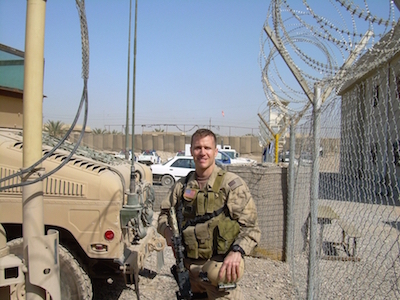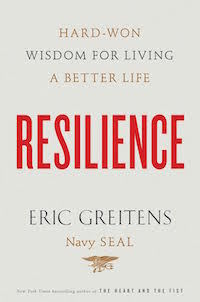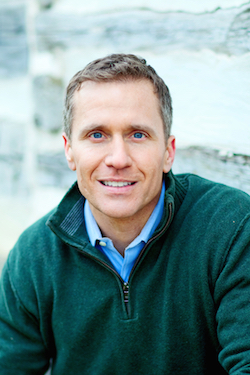Despite our best intentions, all of us have felt stuck in reaction to hardship at some point. It takes a huge mindset shift to recognize that we don't bounce back from bad stuff. We inevitably change, getting less or more resilient.
That's why I recommend reading former Navy Seal and Rhodes Scholar, Eric Greitens' compelling new book on hard-won wisdom for living a better life: Resilience -- out today, March 10th.
In fact, our greatest opportunity for increasingly self-knowledge and growth is through how we face our obstacles. Discover reinforcing evidence of the power of that approach in two compelling books by stoicism advocates, Ryan Holiday in The Obstacle is The Way and Jimmy Soni and Rob Goodman in Rome's Last Citizen.
"What happens to us becomes part of us. Resilient people do not bounce back from hard experiences; they find healthy ways to integrate them into their lives... We can't go back in time to the people we used to be. The parent who loses a child never bounces back," believes Greiten yet we can choose to learn from grief and hardship." Echoing that sentiment Resilience GPS author, Eileen McDargh, writes that "resilience is elasticity."
Yet it usually takes a moment-by-moment self-reminder to recognize that we can use each hardship to become more resilient. In fact this is our path towards building mental toughness, as both Greitens, and former counter-intelligence FBI agent, LaRae Quy, have discovered.
Fitting the Pieces of Your Life Together
To support you on your path towards greater mental toughness, Greitins share this with me:
If I sat down in your living room and placed a giant bag of jigsaw puzzle pieces on a table in front of you and asked you to put all of the pieces together, what's the first thing you'd ask for? First you'd probably ask for a reason. 'Why are you askin' me to do a puzzle?' But if for the moment you accept that you're going to do the puzzle, what would you ask for? I'm guessing you'd ask for a picture. You'd want to know how all of the pieces come together. You'd want to know what you're trying to make.
Here's the thing: Life only hands you pieces.
You have to figure out how to put them together. Your life doesn't come with a picture of what it's supposed to look like on the box. You have to -- you get to -- choose that picture for yourself. And you choose it by looking for a model of a life well lived. In my chapter, "Mastering Pain", I write that you can't really master pain -- pain comes and goes -- some of it we choose and some of it we don't. You can, however, work on mastering yourself. You can build mental toughness in the same way that you build physical strength or moral courage -- through practice. What's tough is that while the world is replete with thousands of diet books and thousands more books on physical exercise, there are few guides to how we build mental toughness. I can't do justice to all that has to be practiced here, but consider just these five practices:
1. Write down what you are afraid of. Writing down your fears puts them in front of you. Fear does its worst work when it knocks around in your mind, hiding in the hollows of your thoughts, waiting to breed with panic, insecurity, and uncertainty. When you write down what you are afraid of, you can begin to gain control of and face your fear.
2. Segment. Learn how to break big challenges down into small pieces. Then attack the pieces.
3. Mentally Rehearse. Just as you can physically practice and rehearse, you can also mentally rehearse. Done well, you build strength and clarity. Done well, you will not be overcome by events, no matter how difficult, because you've thought through hardship ahead of time.
4. Self-Talk. We all talk to ourselves. You may not speak your thoughts out loud or share them with others, but there is always a conversation in your head about your environment and, most important, about yourself. You can't shut this conversation off. The best you can do is to turn it in your favor. There are times when our self-talk becomes destructive. I screwed up. I'm stupid. I don't deserve to be here. Everyone thinks like this occasionally, but repetitive negative inner monologues can be destructive. Gain control of the conversation in your own head, and direct it to help you achieve worthy goals.
5. Breathe. Breathing, like blinking, is one of the few processes in your body that is both voluntary and involuntary. By taking control of your breathing, you can -- this is a crude analogy -- pull a lever on a lot of your other involuntary systems. By learning how to breathe, you learn how to begin to link the mental and the physical. You learn how to start taking responsibility for something very small and very simple, and you build a foundation of practice that will make you stronger.
Make Better Choices by Becoming More Situationally Aware
To become more capable of deep and clear thinking in a situation according to Will Guild, one of Greitin's former military commanders, ask yourself four questions:
1.Why am I here?
2.What's going on around me?
3.What am I going to do about it?
4.How will my actions affect others?
To complement this checklist I suggest that you use "reverse engineering" as a second step: What is my top goal for myself and for the others involved? That step makes it easier to answer those last two questions.
Earn a Purposeful Life With Others
The pull of purpose, the desire to feel needed in the world -- however we fulfill that desire -- is a very powerful force in human life... But you do have to recognize that the drive to live well and purposefully isn't some grim, ugly, teeth-gritting duty. On the contrary, 'it's a very good feeling.' It really is happiness,
writes Greitins. We flourish when we become what we are capable of becoming.
Why Regularly Doing Nothing Is The Best Thing To Do
The Romans were master of builders of things: of digging things out of the ground, of moving things from one end of the Continent to the other, of building towering forts and long walls, stacking thing upon thing...But there's a danger in thinking of reality this way. There is more to our lives than making, buying, building, owning, doing, working,
writes Greitins who notes that the Romans thought the Jews were lazy for taking a whole day off every week, a Sabbath from doing.
Yet we need sacred moments, regardless of the rituals of a religion or sports fan or other focus of our attention and allegiance. ''I heartily agree with Greitens that our meaning and equanimity with which we face life may come from finding and keeping the holy space in time that God has created and commanded humankind to keep."
I would add that even if you do not believe in God, you can experience moments of luminosity. You can feel a state of grace in creating that non-doing, sacred space. And regularly sharing tranquil times with others can strengthen your resiliency "muscle" -- and theirs.



